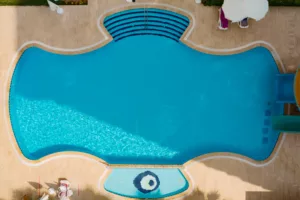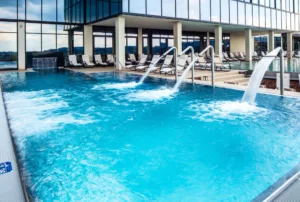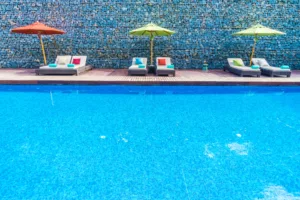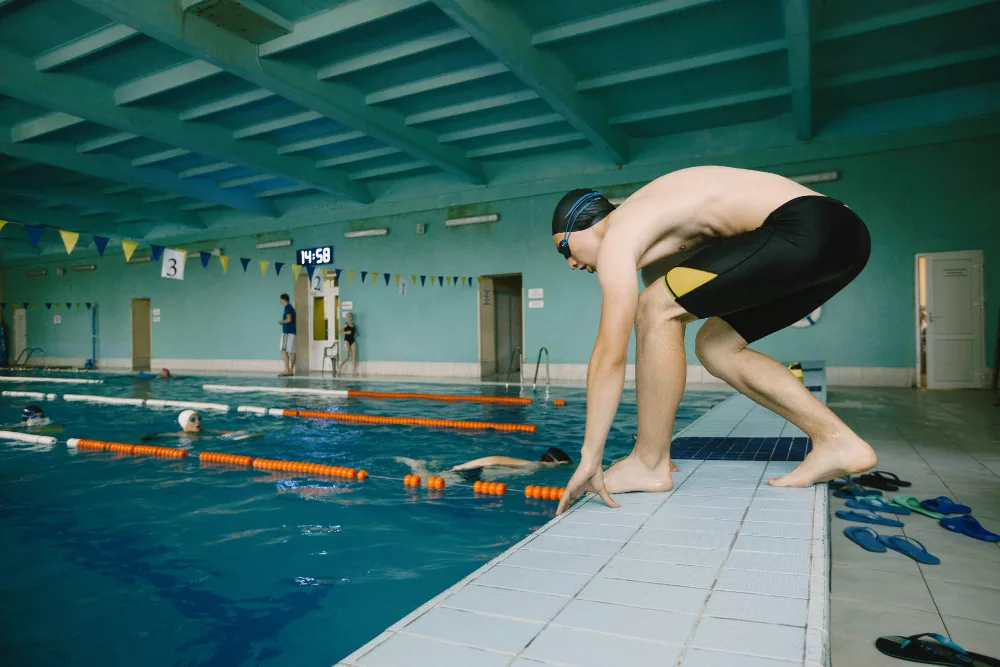Introduction
Salt Water Pool Shock The Importance of Pool Maintenance Maintaining a sparkling clean pool is every pool owner’s dream, and understanding the art of salt water pool shocking is the key to achieving crystal-clear water. But before we dive into the world of pool shocking, let’s first grasp the fundamentals of salt water pool systems, which have gained popularity for their low maintenance and gentle water feel.
Understanding Salt Water Pools
The Basics of Salt Water Pool Systems
Salt water pools have gained popularity for their unique approach to pool maintenance. Instead of manually adding chlorine, these systems generate it naturally through a process called electrolysis. Here’s how it works: salt (sodium chloride) is added to the pool water, and the pool’s salt cell uses electricity to break down the salt into chlorine gas. This chlorine then sanitizes the pool and reverts back to salt, starting the cycle anew. This natural chlorine generation means you don’t need to handle as many chemicals, making salt water pools a convenient choice.
How Salt Water Pools Generate Chlorine
To understand salt water pools shocking, it’s essential to know how these pools generate chlorine. This natural chlorine generation ensures a consistently sanitized swimming environment. The pool’s salt generator, also known as a salt cell, plays a pivotal role. When the pump circulates the pool water, a small electric current passes through the salt cell’s titanium plates. This process splits the salt molecules into sodium and chlorine ions. The chlorine ions, now in a gaseous form, effectively sanitize the pool water. Once their job is done, they revert to their original state as salt molecules, ready to repeat the cycle. This ingenious system keeps your pool water clean and sanitized with minimal effort.

When and Why to Shock a Salt Water Pool
Signs Your Salt Water Pool Needs Shocking
While saltwater pools require less maintenance than traditional chlorine pools, they still need occasional shocking to maintain water clarity and safety. Signs that your pool may need a shock include:
- Cloudy Water: If your pool water looks hazy or cloudy, it’s a clear indicator that it’s time for a shock treatment.
- Algae Growth: Stubborn algae can take hold in your pool, even in a salt water system. If you notice green or slimy patches, it’s time to shock the pool.
- Chlorine Demand: If your pool continually requires more chlorine to maintain proper levels, it’s a sign that organic contaminants are overwhelming the system.
The Science Behind Pool Shocking
Now that we’ve established when to shock your pool, let’s dive into the science behind this essential process. Shocking your pool means adding a large dose of chlorine to the water to break down and neutralize contaminants. While your pool’s salt cell generates chlorine continually, it may not be enough to handle sudden spikes in contaminants or severe water quality issues. Here’s how pool shocking works:
- Oxidation: When you add a shock treatment to your pool, it releases a high concentration of chlorine into the water. This chlorine quickly reacts with and breaks down organic materials like bacteria, algae, and other contaminants.
- Free Chlorine: As the shock treatment works its magic, it temporarily elevates the free chlorine levels in your pool. Free chlorine is the form of chlorine that’s actively sanitizing the water.
- Neutralization: Once the contaminants have been neutralized, they’re converted into chloramines, which are less harmful but can cause unpleasant odors and eye irritation.
- Restoring Balance: After the shocking process, your pool’s chlorine levels may temporarily spike. Over time, these levels will naturally decrease as the chloramines dissipate and the chlorine reverts to salt.

Choosing the Right Shock Treatment
Types of Shock Treatments
Pool owners have several shock treatment options to choose from, each designed to address specific pool water issues. Here are the primary types of shock treatments:
- Calcium Hypochlorite Shock: This type of shock treatment contains a high concentration of chlorine and is effective at quickly eliminating contaminants. It’s ideal for severe water quality issues or algae infestations.
- Dichlor Shock: Dichlor shock contains both chlorine and cyanuric acid. It’s milder than calcium hypochlorite shock and is suitable for routine pool maintenance and less severe water issues.
- Non-Chlorine Shock: This shock treatment, often based on potassium peroxymonosulfate, doesn’t contain chlorine. It’s an excellent option for oxidizing contaminants without adding more chlorine to the pool.
Factors to Consider When Selecting a Shock Treatment
The choice of shock treatment depends on various factors, including the size of your pool, the severity of the water issue, and your maintenance schedule. Here are some considerations:
- Pool Size: Larger pools may require more shock treatment to effectively sanitize the water. Be sure to calculate the correct dosage based on your pool’s size.
- Water Issue Severity: If you’re dealing with severe algae growth or cloudy water, a stronger shock treatment like calcium hypochlorite may be necessary. For routine maintenance, a milder option like dichlor shock is suitable.
- Cyanuric Acid Levels: Consider the levels of cyanuric acid (pool stabilizer) in your water. High levels of cyanuric acid can reduce the effectiveness of chlorine. Non-chlorine shock can help combat this issue.

How to Shock Your Salt Water Pool
Step-by-Step Guide to Pool Shocking
Shocking your salt water pool is a straightforward process, but it’s essential to follow the steps carefully to ensure effective treatment:
- Test Your Water: Start by testing your pool water using a reliable pool water test kit. This will help you determine the current chlorine levels and identify any other water chemistry issues that need addressing.
- Calculate the Shock Dosage: Refer to the shock treatment’s instructions and calculate the correct dosage based on your pool’s size and the manufacturer’s recommendations.
- Distribute the Shock Treatment: Dissolve the shock treatment in a bucket of water before adding it to the pool. This helps prevent the shock treatment from settling on the pool surface, which could damage the liner or create localized high chlorine levels.
- Apply the Shock Treatment: Distribute the dissolved shock treatment evenly around the pool. For best results, pour it in front of the return jets to aid in distribution.
- Run the Pool Pump: Turn on your pool pump to circulate the water and ensure thorough mixing of the shock treatment.
- Wait and Test: Allow the pool pump to run for several hours, and then retest the water to check the chlorine levels. Once the chlorine levels return to normal, your pool is ready for swimming.
Safety Precautions During Pool Shocking
While pool shocking is a routine part of pool maintenance, it’s essential to prioritize safety throughout the process. Here are some safety precautions to keep in mind:
- Protective Gear: Wear protective gear, including gloves and eye protection, when handling shock treatments.
- Keep Children and Pets Away: Ensure that children and pets are kept away from the pool area during and after the shocking process until it’s safe to swim again.
- Proper Ventilation: If you’re using a granular shock treatment, be cautious of the fumes it may produce. Use shock treatments in well-ventilated areas.
- Store Shock Treatments Safely: Store shock treatments in a cool, dry place, away from direct sunlight and moisture. Keep them out of reach of children.
Shocking for Specific Pool Problems
Algae Infestations: A Step-by-Step Solution
Algae are the bane of pool owners, and they can thrive even in salt water pools. To effectively tackle an algae infestation, follow these steps:
- Identify the Algae: Determine the type of algae infesting your pool. Common types include green, yellow, and black algae, each requiring a different approach for elimination.
- Brush and Vacuum: Brush the pool walls and floor to dislodge algae and vacuum the pool to remove debris.
- Balance the Water: Ensure that your pool’s pH and alkalinity levels are within the recommended range before shocking.
- Shock the Pool: Use a strong shock treatment, such as calcium hypochlorite shock, to target the algae. Follow the dosage instructions carefully.
- Scrub and Brush Again: After allowing the shock treatment to circulate for a few hours, thoroughly scrub the pool’s walls and floor again to remove dead algae.
- Run the Pump: Keep the pool pump running to help filter out dead algae.
- Retest and Repeat if Necessary: Repeated shock treatments may be necessary, depending on the severity of the algae infestation. Retest the water and repeat the process as needed until the pool is clear.
Clearing Cloudy Water
Cloudy pool water can be caused by various factors, including poor water circulation, high pH levels, or an inadequate chlorine-to-contaminant ratio. Here’s how to clear cloudy water:
- Test and Balance: Test your water and ensure that pH and alkalinity levels are within the recommended range. Adjust as needed.
- Clean the Filter: Ensure your pool filter is clean and functioning correctly. Backwash or clean the filter according to the manufacturer’s instructions.
- Brush and Vacuum: Brush the pool’s walls and floor to loosen debris and vacuum to remove it.
- Shock the Pool: Add the appropriate shock treatment to the pool based on the manufacturer’s recommendations and the water’s condition.
- Run the Pump: Keep the pool pump running to aid in water circulation and filtration.
- Retest and Repeat if Necessary: After several hours, retest the water. If it remains cloudy, repeat the shock treatment process until the water clears up.
Routine Shocking and Maintenance
The Importance of Routine Pool Shocking
While shock treatments are often used to address specific water issues, incorporating routine pool shocks into your maintenance schedule is crucial for long-term pool health and water clarity. Regular shocking helps prevent water problems before they become severe.
Weekly, Monthly, and Seasonal Shocking Schedules
The frequency of routine pool shocks depends on factors like pool usage, weather conditions, and bather load. Here are different shocking schedules to consider:
- Weekly Shocking: For heavily used pools, consider shocking the pool once a week to maintain optimal water quality.
- Monthly Shocking: Pools with moderate use may benefit from monthly shock treatments to prevent the buildup of contaminants.
- Seasonal Shocking: If you close your pool during the winter or use it infrequently, perform a shock treatment before closing and when opening the pool for the season.
Troubleshooting Common Pool Shocking Issues
Dealing with Over-Chlorination
Occasionally, pool owners may accidentally over-chlorinate their pools during shock treatments. Over-chlorination can lead to excessive chlorine levels, which can irritate swimmers’ eyes and skin. If you find yourself in this situation, here’s how to address it:
- Measure Chlorine Levels: Use a pool water test kit to measure the current chlorine levels in your pool.
- Dilute the Water: If the chlorine levels are extremely high, consider partially draining the pool and adding fresh water to dilute the chlorine.
- Monitor and Retest: Keep a close eye on the chlorine levels and continue testing until they return to a safe range for swimming.
Addressing Persistent Algae Problems
If algae problems persist despite regular shocking and maintenance, it’s time to take more aggressive action:
- Superchlorination: Perform a superchlorination treatment by adding a significantly higher dosage of shock treatment to the pool. Follow safety precautions and manufacturer instructions.
- Algaecide Use: Consider using an algaecide in conjunction with shock treatments to target stubborn algae strains.
- Scrub and Brush: Frequent brushing and scrubbing of pool surfaces are essential to dislodge algae and allow shock treatments to work effectively.
- Consult a Professional: If persistent algae issues continue, consider consulting a pool professional for expert advice and assistance.
Sustainable Pool Shocking Practices
Eco-Friendly Pool Shocking Options
As the world becomes increasingly eco-conscious, many pool owners are seeking eco-friendly pool shocking alternatives. Here are a few options to consider:
- Non-Chlorine Shock: Non-chlorine shock treatments are less harsh on the environment and still effectively oxidize contaminants.
- Enzyme-based Products: Enzyme-based pool products break down organic matter naturally, reducing the need for traditional shock treatments.
- UV or Ozone Systems: Consider investing in UV or ozone systems, which reduce the reliance on chlorine or shock treatments for sanitation.
Maintaining Water Balance and Sustainability
To reduce your pool’s environmental impact and maintain sustainability, follow these practices:
- Regular Water Testing: Test your pool water regularly to ensure it’s balanced and doesn’t require excessive shock treatments.
- Minimal Chemical Use: Use chemicals sparingly and follow dosing instructions to avoid overuse.
- Proper Filter Maintenance: Clean or backwash your pool filter as recommended to maintain efficient water circulation.
- Reduce Energy Consumption: Use energy-efficient pool pumps and timers to reduce energy consumption.
Conclusion: Salt Water Pool Shock
As we conclude our journey through salt water pool shock, you now have a comprehensive understanding of how to maintain crystal-clear water in your pool. Whether you’re dealing with algae or cloudy water, or simply want to ensure routine maintenance, proper pool shocking techniques are essential. Remember to test your water regularly, follow safety precautions, and select the right shock treatment for your pool’s specific needs. By incorporating these practices into your pool maintenance routine, you’ll enjoy pristine, inviting water that beckons you to dive in
FAQs: Salt Water Pool Shock
Q1: Can I swim in the pool immediately after shocking it?
- A1: It’s best to wait until the chlorine levels return to normal, which typically takes a few hours. You can accelerate this process by running the pool pump and ensuring proper water circulation.
Q2: Is it possible to over-shock a pool?
- A2: Yes, over-shocking a pool can lead to excessively high chlorine levels, which can be harmful to swimmers. Follow the manufacturer’s instructions for shock treatment dosage and monitor chlorine levels closely.
Q3: Can I shock my pool during the day, or is it better to do it at night?
- A3: Shocking your pool during the day is fine, as long as you follow safety precautions. However, some pool owners prefer shocking at night to minimize chlorine loss due to sunlight.
Q4: Are there alternatives to shock treatments for pool maintenance?
- A4: Yes, alternatives like non-chlorine shock, enzyme-based products, and UV or ozone systems can reduce the reliance on traditional shock treatments while maintaining water quality.
Q5: Can I use regular table salt in my salt water pool?
- A5: No, you should use pool-grade salt specifically designed for salt water pools. Table salt may contain additives that can harm your pool equipment and affect water balance.






